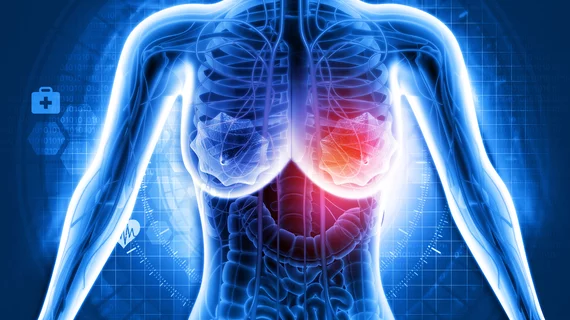‘Wake-up call’: Providers log substantially fewer breast biopsies with cancer diagnoses
Providers logged substantially fewer breast biopsies with cancer diagnoses during the earlier days of the pandemic, according to new data one expert labeled a “wake-up call” for the specialty.
The declines were more pronounced among Asian (down 53% compared to 2019), Latina (43%) and Black women (27%), experts wrote Tuesday in Radiology. Overall, radiologists diagnosed 24% fewer breast cancer cases between March and September of 2020 when compared to historical data.
While numbers from the Breast Cancer Surveillance Consortium—a collaborative network of cancer imaging registries—did bounce back eventually, researchers still see cause for concern.
“Despite the swift return to pre-pandemic monthly volumes, as of July 2020 year-to-date screening and diagnostic mammography examinations in the BCSC were only 66% and 80% of expected volumes, respectively, indicating a substantial deficit in breast cancer screening accumulated during the early stage of the pandemic,” radiologist Kathryn Lowry, MD, with the Seattle Cancer Alliance, and colleagues wrote Oct. 19. “Moreover, these deficits were largest in Hispanic and Asian women, adding to existing evidence that the COVID-19 pandemic has disproportionately impacted minoritized racial and ethnic groups.”
For the study, Lowry et al. analyzed prospectively collected monthly breast biopsy data following an imaging test across 66 facilities taking part in the consortium. They found marked declines in diagnoses, primarily due to fewer screen-detected cases (down 38% vs. 2019) with symptomatic cancers dropping only 7%. Decreases were smallest among non-Hispanic white women at 17%.
In a corresponding editorial, radiologist Samantha Heller, MD, PhD, called the findings a “wake-up call for action” to address disparities in minority populations.
“The authors’ finding that the pandemic predominantly affected cancer yields for certain populations—Asian women, as well as Hispanics and Blacks—is especially troubling,” wrote Heller, an associate professor in the Department of Radiology at NYU Grossman School of Medicine. “The pandemic has exposed deep fault lines of inequity in our healthcare system. If the observed screening and cancer diagnosis gaps lead to longer-term prognostic consequences, then this may turn out to be yet another way in which the pandemic inequitably affects distinct groups.”

